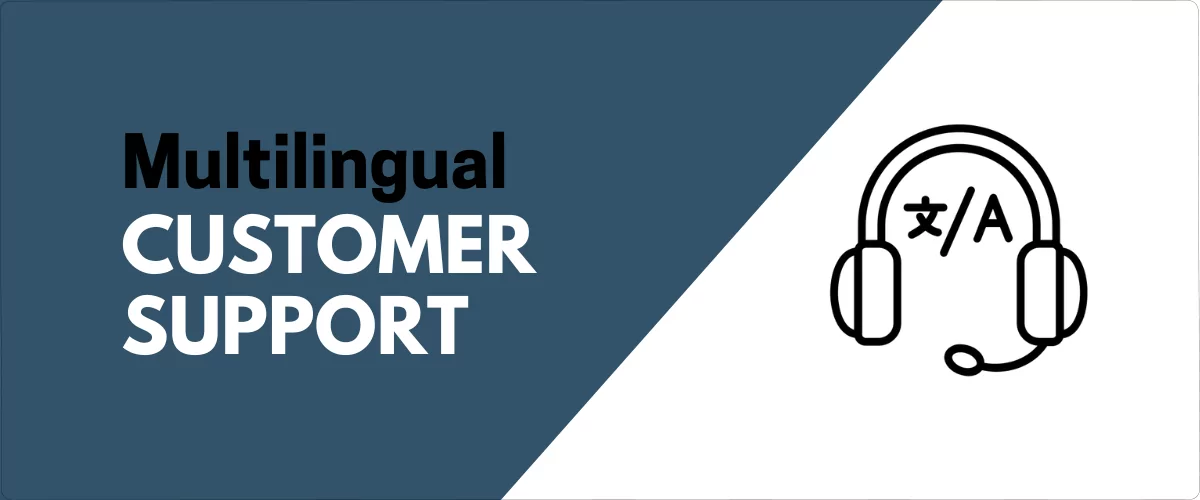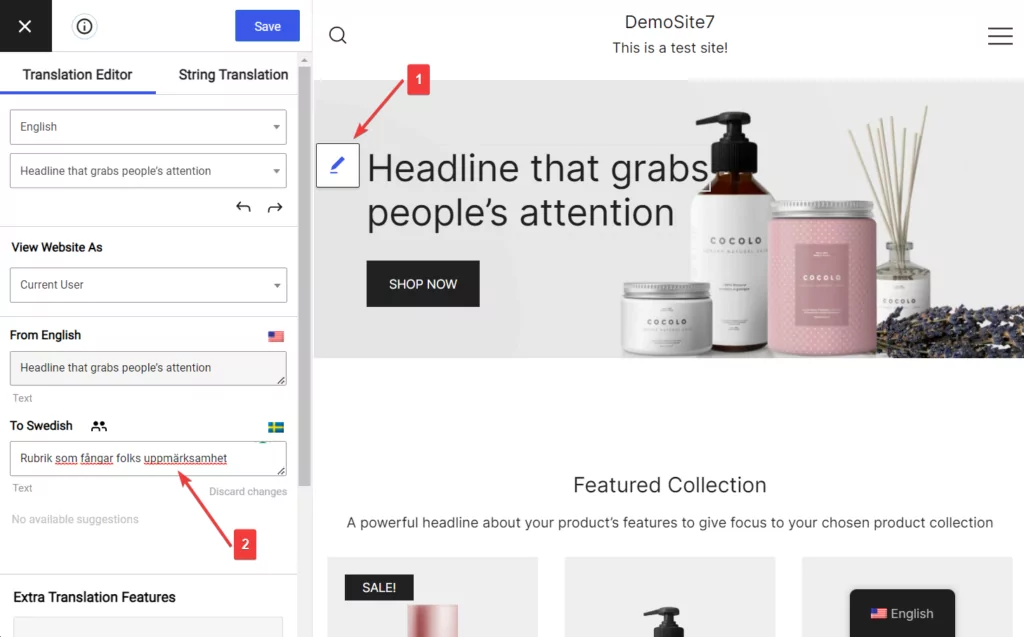
In this post
The market is no longer local. It extends beyond borders. That has made multilingual customer support a necessity instead of a good-to-have.
It helps you communicate effectively with a diverse customer base, and enhance their experience and loyalty.
Consider this: 29% of businesses lose customers due to a lack of multilingual support, while 71% of users reported increased loyalty to companies offering support in their native language.
Moreover, 40% of global consumers said they don’t buy from companies not offering native language support, leading to significant revenue loss.
This article explores the top 10 reasons multilingual customer support is crucial and provides actionable steps for implementation.
Understanding the Languages Your Customers Speak
Language is more than a communication tool—it’s a strategic asset. The ability to talk to customers in their native tongue can significantly impact your business, shape customer experiences, and influence purchasing decisions.
A CSA Research study found that 65% of online shoppers prefer buying products with the information provided in their native language.
And 40% of shoppers won’t buy if the page is in another language.
However, providing multilingual support can be difficult. Businesses often have to justify the ROI behind investing in additional resources.
That’s why there are many modern tools and APIs that help you translate text at scale.
They integrate with existing technology stacks. Some tools can even auto-translate conversations between customers and agents, making it easier for both parties to talk in the language they prefer, with no barriers.
Top 10 Reasons Why Multilingual Customer Support is Important
Let’s look at the top most important reasons why multilingual support should be implemented for your business.
1. Improved communication experience and quality
Clear communication is the backbone of great customer service. When you provide multilingual support, customers can interact with you in their preferred language.
This leads to better understanding and fewer misunderstandings, which improves customer satisfaction and loyalty.
Being able to communicate proactively with customers in their native tongue shows you care. It helps them through their customer journey and makes them feel like part of your “family.”
Customers value that and are less likely to switch to another company.
2. Enhanced customer experience and satisfaction
Customers feel more comfortable and valued when they can interact with you in their native language. This enhances the customer experience and boosts satisfaction levels.
Higher customer satisfaction increases repeated purchases and positive word-of-mouth referrals.
Multilingual support enhances the experience by ensuring customers can get help however they communicate best, leading to increased satisfaction and loyalty.
3. Increased support team efficiency through faster issue resolution
Efficiency is key to good customer service. Being able to resolve issues quickly and properly leads to happier, loyal customers.
Multilingual support teams can solve issues faster because they fully understand the problem in the customer’s language. This translates into shorter resolution times and a more productive team.
Better efficiency impacts the bottom line. It reduces costs by shortening interactions so representatives can help more customers in less time.
It also increases revenue through improved satisfaction and repeat business.
4. Boost customer loyalty
Nothing builds loyalty like making customers feel understood. When you provide support in a customer’s native language, it shows you care and wants to help them succeed.
To further enhance the benefits, you could create a membership for your brand. Membership and loyalty programs incentivize customers to keep coming back and referring others—that’s critical for growth.
5. Gain a competitive edge
You need every advantage you can get. Providing multilingual support gives your business an edge.
It shows you value diversity and want to serve all kinds of customers. This can set you apart from companies that only provide support in one language.
More potential customers see your business as a good fit, helping you attract new business.
6. Reach a global audience
More and more businesses are going global and multilingual support allows you to effectively serve customers from all over the map.
This opens up new markets and sales opportunities, expanding your impact and reach. The more people you can help, the more your business can grow.
The theme you pick also matters because we need it to support the other languages. The majority of the popular WordPress themes are built with global audiences in mind.
For example, the most popular theme, Astra, is a lightweight, customizable theme that’s also translation and RTL-ready, making it a great choice for multilingual websites.
7. Better product understanding
When support is provided in a customer’s native language, they understand your product much better. This leads to increased use of the product and higher satisfaction.
It can also reduce returns and drive repeat purchases. Helping customers succeed with your product is great for business!
For instance, if you run an online store, you should consider integrating WooCommerce with a CRM to get more data on your customer’s expectations.
8. Increased sales opportunities
Sales are the lifeblood of any business. But truly profiting from the global markets requires speaking the language that effectively reaches your customers.
When you communicate with prospects in their language, you remove the unfamiliarity allowing for a smooth sales and checkout experience.
9. A stronger brand reputation
Multiple language support shows you respect customers regardless of background. This inclusivity builds a brand reputation that attracts more worldwide customers, fueling growth.
Choosing the right languages makes communication easy for global customers, gaining brand advocates.
Speaking your customer’s language demonstrates understanding, building worldwide trust and setting yourself up with a strong reputation.
10. Reduced churn rate
Churn rate is the percentage of customers you lose over time. It could be due to multiple reasons — one of them being communication barriers.
Providing support in customers’ preferred languages helps them feel truly understood, which can improve loyalty.
When people feel valued as part of your business, they’re less likely to switch to competitors.
This reduced churn translates into higher customer retention and stability for healthy business growth.
Tips for Transitioning to Multi-language Support for Your Site
Do you want to upgrade your site and welcome users from around the globe? Hell yeah, that’s an epic move!
Going multilingual will open you up to a whole new world of customers and major growth opportunities.
- Identify the languages your customers speak: Before you begin translating your site, figure out who your visitors are. Check the demographics of your current customers to see what languages they speak. Then prioritize the regions with the highest conversion rates and revenue potential. This way, you save time and resources while also making impactful changes at every step.
- Choose the right translation tool: With the languages figured out, it’s time to pick a translation tool. As a WordPress user, I’d recommend going with TranslatePress. This plugin lets you translate your site visually on the front end, so you see the changes as you make them. It supports 221+ languages and provides SEO benefits like translating page titles, descriptions, and URL slugs
- Create a translation plan: Once you’ve selected your translation tool, develop a comprehensive translation plan. Map out what site content needs translation, who will perform the translations, and timelines for completing each section. Consider starting with high-value pages like product, landing and support pages.
- Test your translations: Before going live with your multilingual site, put those translations to the test. Make sure everything is accurate and all parts of your site function properly for each language.
- Get feedback: Get feedback from your current customers. See if the translations resonate with them and if the site is easy to navigate. Tweak anything necessary based on their input.
One of the best features of TranslatePress is its automatic translation functionality, through the Google Translate or DeepL APIs, which accelerates the initial translation of your content.
You can then manually refine any machine translation inaccuracies from the visual editor as well.

TranslatePress can also automatically detect a user’s language based on their browser settings and redirect them to the right language content.
This provides an awesome personalized experience for your global visitors right from the start.
Grow Globally Through Multilingual Customer Support
A multilingual strategy isn’t just a “nice to have” —it’s the only way to thrive.
Talking to your customers in their own language helps you:
- Build stronger connections that improve the customer experience;
- Gain loyalty from customers who appreciate being understood;
- Reach more global customers and expand your market reach;
- Strengthen your brand across international borders.
The benefits of multilingualism aren’t measured in profit margins alone. You also boost brand awareness exponentially and watch your bottom line grow consistently.
With modern translation tools like TranslatePress, the costs have never been lower. So the ROI for enabling multilingual support is justified.
TranslatePress Multilingual
As more people connect on the internet, reducing the global borders, companies that come out on top will be those that serve international customers.
And your success depends on the ability to communicate across languages and borders. The opportunity is right here — are you ready to take advantage of it?


